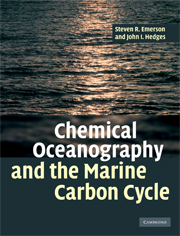Book contents
- Frontmatter
- Contents
- Preface
- Acknowledgements
- I Introduction to chemical oceanography
- 1 Oceanography background: dissolved chemicals, circulation and biology in the sea
- 2 Geochemical mass balance: dissolved chemical inflow and outflow from the ocean
- 3 Thermodynamics background
- 4 Carbonate Chemistry
- 5 Stable and radioactive isotopes
- 6 Life processes in the ocean
- 7 Paleoceanography and paleoclimatology
- II Advanced topics in marine geochemistry
- Index
- Plate section
- References
5 - Stable and radioactive isotopes
Published online by Cambridge University Press: 05 September 2012
- Frontmatter
- Contents
- Preface
- Acknowledgements
- I Introduction to chemical oceanography
- 1 Oceanography background: dissolved chemicals, circulation and biology in the sea
- 2 Geochemical mass balance: dissolved chemical inflow and outflow from the ocean
- 3 Thermodynamics background
- 4 Carbonate Chemistry
- 5 Stable and radioactive isotopes
- 6 Life processes in the ocean
- 7 Paleoceanography and paleoclimatology
- II Advanced topics in marine geochemistry
- Index
- Plate section
- References
Summary
Analyses of stable and radioactive isotope compositions have become a mainstay of the chemical perspective of oceanography, owing in large part to their value as tracers of important oceanographic processes. The utility of isotopes as tracers of biological, physical and geological ocean processes is perhaps the main reason that chemical oceanography has become a strongly interdisciplinary science. Small contrasts in stable isotope compositions can carry geographic information for discriminating sources such as different ocean water masses, and marine versus terrestrially derived organic matter. Within fossils, isotope distributions afford information about the temperatures, geographic settings, transport mechanisms, and ecology (e.g. who ate whom) of ancient environments. Stable isotope compositions also integrate the cumulative results of ongoing processes such as the passage of organic elements up trophic levels, climate change, marine productivity, and the formation and melting of continental glaciers. Stable isotopic signatures can persist over geologic time, even through severe changes in chemical composition. Radioactive isotopes have the additional property of being useful as nuclear clocks that, regardless of environmental conditions, dependably tick away to indicate the age of an object or the dynamics (e.g. turnover time) of a pool of materials. In addition, nuclear decay events often involve conversions of parent isotopes to daughter elements with very different physical and chemical properties, which then can be sensitively traced as they seek new chemical forms and locations in the ocean.
- Type
- Chapter
- Information
- Chemical Oceanography and the Marine Carbon Cycle , pp. 134 - 172Publisher: Cambridge University PressPrint publication year: 2008
References
- 1
- Cited by



